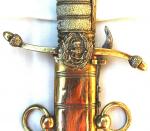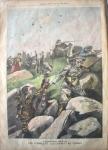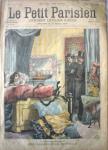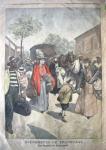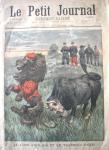-
Posts
13,225 -
Joined
-
Last visited
-
Days Won
22
Content Type
Profiles
Forums
Blogs
Gallery
Events
Store
Everything posted by Mervyn Mitton
-
-
-
-
Close-up of this central section. You will see that there is a strong clip to prevent the blade falling from the scabbard.
-
This is the side that faces outwards. Note the standard Lion's head - this is on all Naval edged weapons for officers. The skin of the grip is from a Ray - most people think shark - but, that has bigger bubbles in the skin. Some dirks have two rings on the same side - this was to carry it in the trail position. By this date the rings are opposite each other and it was carried in the vertical position on the left hip. The ring in the Lion's mouth was for the standard Naval Dress knot that went over the wrist to prevent it being dropped. Acorns (from Oak trees - very symbolic) tip the cross guard and at the Forte is Edward's Crown with the Naval Fouled Anchor.
-
The length of this beautiful dirk is 21 inches ( overall and the blade alone - 18 inches. (66cms. & 46 cms)
-
Having existed as a Service for so many centuries , it is not surprising that the British Royal Navy has so many variations in ranks, uniforms and equipment. In the very early days - for example the 14th Century - the Captain and crew were professional sailors, responsible for sailing the ship. However, the soldiers who fought on her were in charge and gave the orders. By the 17th C. the running of a man-of-war had a more followed order and a ranking of commissioned officers, warrant officers, petty officers - and of course the crew. Ships in the early days always had 'ship's boys' to help on board and carry gun powder in action. There was another tier of youngsters above them - but, again from as young as 12 years - they were called Midshipmen . They were rated as senior petty officers, but only paid as able seamen. Although they had their own Mess, they were not officers - really just being trained to sit and pass the Lieutenants examination - then they became sub-Lieutenants. The big difference was that they were graded as Gentlemen and could therefore be treated as such. They were entitled to wear a sword - however, most of them were too small and so the Dirk came into being. Naval Officers' requested King George 2nd. to grant them a standardised uniform and this happened in 1748 - the young Gentlemen - as Midshipmen were often called were also given a first uniform. Probably from this time the wearing of a dirk became part of dress. The early ones varied in shapes and sizes and were not made to follow a pattern until Victorian times. The lovely example I am showing here dates from the early years of King Edward 7th (1901-1910) - it is his Crown that is on the ornament at the Forte with the Naval fouled anchor. The engravings on the blade, are however , of the pattern used in the later year's of Queen Victoria. Presumably they had stocks made during her lifetime ? 'ECMDD' are the initials engraved on the throat of the scabbard and with so many initials it would indicate an important family. Young officer's were often presented with swords on their appointments - and Naval tradition is similar. SO, the question is - who was he ? We are looking back at just over 100 years ago and with so many initials it should be possible to find out his background - after all - he has two World Wars in front of him - what rank could he have achieved ? I wuld be grateful for any help or, advice on how we research him ?
-
Well - I think it was very interesting and amazing that such pieces can still turn-up like this. Thankyou both, for the trouble. However, it would have been nice to see a photograph - I couldn't find one on all the links - probably hit the wrong ones ? Mervyn
-

Pakistan Field Marshal shoulder boards - interesting variant
Mervyn Mitton replied to achern's topic in South Asia
Alf - must have been for field service ? Interesting the way British influence still persists years after the Colonial links have been broken. I wonder if a Pakistan FM actually carries a Baton as on the Rank ? -
David - sorry , I got mixed up with the posts - not too difficult, I've had years of practise ! I would say Yes - it is probably for African Police. However, there are two other possibilities - 1. For a guard. 2. A Zulu Dancing stick - the tapered end makes me think this could be a possibility. I will get someone to photograph my example and then you can compare. Mervyn
-
Alf - sorry if I "frightened' you with my long list for a possible article. I am sure whatever you write will be very welcome - and of course we will leave it to you to do what you are comfortable with. Senior officers do go through phases with their insignia - I have noticed that British Police Chief Constables have - for example - started to enlarge their shoulder rank insignia. ** I should have mentioned - three Forums down GB Empire Colonial Sth. Africa etc.. Bottom of page 1 I did a post on British Generals of the Boer War. Lots of good illustrations which may be of some help.
-
This is the back cover - it also gained great attention due to it's distorted and biased view of the war. They are trying to portray how the evil British were being held off by whole families trying to defend their homeland. Good sentiments - but, as I said - seen through the eyes of an artist trying to sell papers and include some propaganda against the 'other side' at the same time........... The picture is showing Boer Commandos' firing at the British and their wives and children bringing-up ammunition under British fire. Needless to say, the obligitory 'small boy' has just been shot whilst handing ammo. to his Father. The only way that could have happened is if the Brit. soldier had been in a plane - but, let's not worry too much about accuracy.
-
I think this is an issue from 1900 - it is the back cover which is of interest. However, this lurid picture on the front cover shows the quality of the magazine - and the readership it was aimed-at. The men are Police detectives and were trying to arrest the woman - however, she had poisonous snakes all over her bed to stop them C'est la vie !
-
This is the rear cover for the same edition - it is a little more factual in it's approach. The French always talk as if the war was only in the Transvaal - whereas it encompassed all main Provinces. This shows the evacuation from the Transvaal and the arrival of fleeing civilians at Ladysmith in Natal - a distance of some 400 miles (600kms). One of the interesting portrayels is the presence of African servants and helpers. This did happen and thousands were brought into Natal . I think that there was an encampment within Ladysmith during the siege which had some 2500 African people - and they suffered the same hardships and food shortages.
-
Odulf's interesting post on the French antiBritish propaganda in Petit Parisien for the Boer War has made me look out some of the copies I have. Only the Front and back covers were coloured lithographs I will show most of them over the next few months - they are now historical documents over 110 years old. I will show the front and backs of two editions to start : This first issue - 10th November 1900 - is one of the most famous. The caricature of the British Lion being gored by the Kruger Bull was re-published Worldwide and of course, showed clearly on whose side the French were. You will note the military figures in the background - these were intended to represent the major powers watching with concern. They represented France, Germany, Russia, Italy, Spain etc..
-
Cathey and Rex - thank you for taking the time to post the prints. For older British people they have great nostalgia - they take you back to a period when Britain was Great and her unemployed were sent to war and didn't riot in the streets. I come from a family with a military background and as a small boy (prob. 7 or,8) used to sit in my Grandmother's front parlour and look at the 'Thin Red Line' - probably, like all little boys made-up my own stories about them ? Her house was littered with the old slate clocks that used to be given when someone was promoted or, transferred. I would think at that period that most houses in the UK had this print ? Nelson is another matter - we were brought-up on the stories of his tactics and battles. The farewell before going on board HMS Victory was also to be found in the homes of most of my Grandparents' generation. Poignant and with a sense of history and our former glory ! I lived at Blackheath in London as a boy during the War and often visited the Maritime Museum in Greenwich. Once again - thankyou - and I know from comments, that we look forward to seeing others in your collection.
-
Hi - Ian. Yes, a first for me too ! Obviously the carving was done by the person it was issued to - but it clears up a lot of queries on dates etc.. I would still like to find out exactly what duties they performed ? I used to have in the collection a small version - I think it was 7 inches long ( 17.5 cm) - this was intended to be used as a Tipstaff to show the bearer's authority - so, they were more then watchmen. Your small knobkerrie certainly looks to have had a police use - the one I have is probably Durban Municipality and is older. I will post a picture. (Ann, I don't want any comments about the last sentence......................)
-
Zulu weaponry of quality and age is becoming scarcer all the time - you have to remember that at the time of the Anglo-Zulu War of 1879 the numbers of Zulus is estimated at between 250,000 & 300,000. For perspective - the number of Europeans living in Natal at that time was only about 8,000 ! I recently bought this superb example of an Iwisa - or, knobkerrie. This is a fighting one - with a mushroom top to inflict very serious wounds. However , it had the secondary use of being decorative and therefore, giving status to the owner. He would almost certainly have been a Chief or, senior Induna. The quality of the hand woven brass and copper bindings is of a high order - and it is possible that a further band went around the bottom of the mushroom. Five bands of this quality is rare. The brass and copper wire came from the Portuguese settlement at Delgoa Bay - the Zulus used to exchange ivory and skins. A valuable item.
-
Alf - a history of senior officers' insignia over the past few hundred years. With llustrations I think it would make a very different - and important - article. For length - as long as you need - but, as a guide - about 5 or 6 A4 size + photos. Once questions start to come-in you will be able to enlarge on points. Once we see the content , Brian and I will be very happy to consider it for pinning and also the 'Moderators' Choice' panel. This remains with the thread even when un-pinned. We read every post with a view to doing this as a thankyou.
-
Nick - have just noticed something very interesting on your Shako. I think it is an Inspector wearing this one. From the mirror you can see what looks like braid on the peak - and the epaulettes are not numbers - they look more like rank pips - but side by side and not one above the other. OK that should get everyone looking - would make it very revolutionary - perhaps for Specials ? Also, he is carrying a stick - traditional in Midland Forces.
-
Justin - this is a good topic and to collect British Tallies you do need some advice. Hopefully, there will be other members with a similar interest to give you pointers. One of the things to have to be careful of, is that there are a lot of later copies for the more famous names in warships. For example - HOod , or the REPULSE - you would be lucky to buy a genuine one over the counter - but that doesn't mean they aren't available. There was a post a little time ago that outlined some of the changes between the Wars. I can't remember where it was now - may have been on this Forum? I have some on a board and will post them for you to see. ps. I have just googled 'books on british cap tallies' and some interesting sites came-up. By about page 1001 you should find some books listed.................






